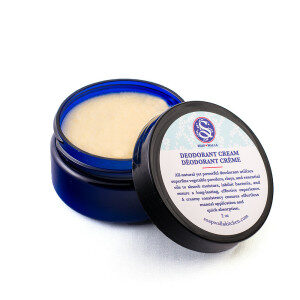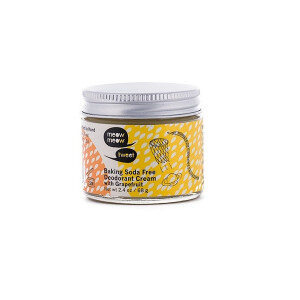Let’s play a game of health Jeopardy.
Linked to Alzheimer’s, Parkinsons, breast cancer, and ALS, this neurotoxin attacks the nervous system and degenerates the brain.
What is aluminum?
Correct. Aluminum, although effectively everywhere around us, has been found to contribute to deadly and life-altering conditions when accumulated in the body over time.
Unlike metals that are essential to human health, such as iron, zinc, copper, and manganese (albeit only in trace amounts), aluminum is not needed by the body at all but finds it way inside via your environment. Aluminum can be found in cookware, construction materials, non-filtered water, and in skincare products.
I’ve been worried about aluminum in my products for a long time, most notably, in my deodorant. A quick look at my go-to antiperspirant revealed I was applying a product with 18.2% Aluminum Zirconium Tetrachlorohydrex (quite the mouthful) on a daily basis. Eighteen-point-two-percent. Every day. I decided to change that.
The first time I was tipped off to “organic deodorant” was sometime in high school when I tried a roll-on, aluminum-free alternative that was watery and didn’t do much. Since then, my experience has been non-existent but my outlook was hopeful. I could find something that was both good for my body and good for my… bodily scent, right?

 To find out if organic deodorants had evolved since my high school days, I tested two options: Meow Meow Tweet’s Baking Soda Free Deodorant Cream with Grapefruit and Soapwalla’s Deodorant Cream. Both come in little tubs and must be applied using your fingers. Using only certified organic or food-grade ingredients, these jars of seriously sensational smelling cream drop skincare gold names in their ingredient lists like it’s their job (which it kind of is): jojoba oil, shea butter, coconut oil, bergamot, sweet orange, rosehip, lavender, tea tree leaf oil, and more. Their delicious scents in combination with the impressive lists of natural ingredients made me wonder if I should apply the cream to my underarms or eat it (Note: do not eat it). I went with their intended purpose and applied to my underarms.
To find out if organic deodorants had evolved since my high school days, I tested two options: Meow Meow Tweet’s Baking Soda Free Deodorant Cream with Grapefruit and Soapwalla’s Deodorant Cream. Both come in little tubs and must be applied using your fingers. Using only certified organic or food-grade ingredients, these jars of seriously sensational smelling cream drop skincare gold names in their ingredient lists like it’s their job (which it kind of is): jojoba oil, shea butter, coconut oil, bergamot, sweet orange, rosehip, lavender, tea tree leaf oil, and more. Their delicious scents in combination with the impressive lists of natural ingredients made me wonder if I should apply the cream to my underarms or eat it (Note: do not eat it). I went with their intended purpose and applied to my underarms.
While I’m mostly as cool as a cucumber, I am not one of those “never sweats the small stuff” kind of women. I sweat the small stuff; I actually sweat all the stuff. I sweat walking from here to the corner (trust me, it’s not far) and have been hesitant to try organic deodorants because I doubted they could hold up. I was sure they would leave me noxious and embarrassed at the end of the day, gripping my arms to my sides and never raising them for fear of offending my poor, defenseless colleagues.
Well, I was in for a treat. Both products not only kept me smelling sweet all day but also stood up through my regimented trials of working out, running up and down subway stairs, being jam-packed in strangely humid train cars (why is there a cloud in here?), and my general, harried, running-around mania.
Organic deodorants, although formulated to wick away moisture and prevent bacteria, are not designed to be antiperspirants. Therefore, they do not swell your sweat glands, inhibiting your body from sweating, and you shouldn’t expect to be completely dry all day. I understood this and, although anticipating moisture, was pleasantly surprised by how dry my underarms felt. The creams can absorb some moisture and, in my tests, did a pretty good job of keeping me dry enough and pit-mark free.
Conclusion? I highly recommend. I’ve ditched my aluminum-laden former love and am now a total organic deodorant cream convert. The application process took some getting used to, having to dip my finger in the product and massage into my underarm area, but even that has become a normal part of my routine.
And if protecting my body from toxic elements shouldn’t be routine, I don’t know what should.